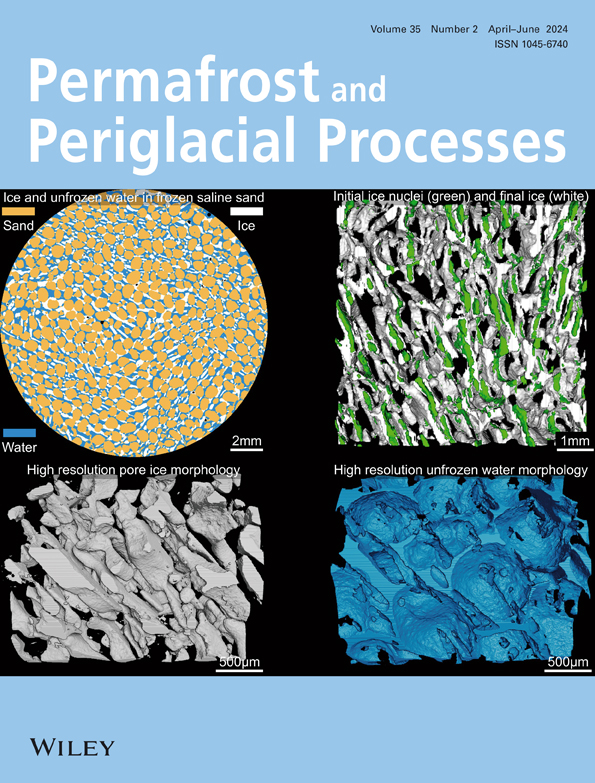Tarnów高原东部边缘覆盖层和沉积物的气候变化记录(波兰东南部)
IF 3.3
3区 地球科学
Q2 GEOGRAPHY, PHYSICAL
引用次数: 0
摘要
表层沙(CS)是欧洲砂带内最独特的沉积物之一。在位于Tarnów高原(波兰东南部)Wisłoka河谷边缘的Góra Motyczna遗址记录到了超过6米的异常厚度。所研究CSs的沉积记录将其排列设置为两个沉积旋回之一。各岩相由砂质(A1和A2)和粉质(B1和B2)岩相组成,形成A1 ⇒ B1 ⇒ A2 ⇒ B2序列,该序列被认为是魏克塞利亚晚更新世气候变化的记录。砂质岩相堆积发生在干燥和无雪的气候条件下,而粉砂质岩相堆积标志着由于积雪的存在,湿度增加。沉积物光学测年表明,所研究的CS沉积的时间为~18-17至~16-15 ka。因此,石英颗粒形状和表面类型的分析证实了堆积期短。由于这一时期风成过程的短暂性,唯一表现出的变化是颗粒表面微起伏;因此,石英颗粒已经从其来源环境和早期过程中继承了其形状和圆度。源沉积物可能是中新世和第四纪与井喷有关的放气沉积物的人工制品。本文章由计算机程序翻译,如有差异,请以英文原文为准。
Climate change records in coversand deposits from the eastern margin of the Tarnów Plateau (southeast Poland)
Coversands (CSs) are one of the most distinctive sediments within the European Sand Belt. Their extraordinary thickness, exceeding 6 m, was recorded at the Góra Motyczna site located at the edge of the Wisłoka River valley in the Tarnów Plateau (southeast Poland). The sedimentary record of the studied CSs sets their arrangement into one of two sedimentary cycles. Each consists of sandy (A1 and A2) and silty (B1 and B2) lithofacies, forming an A1 ⇒ B1 ⇒ A2 ⇒ B2 sequence that is considered to be a record of climate change during the Weichselian Late Pleniglacial. Sandy lithofacies accumulation occurred under dry and snow‐free climatic conditions, whereas silty lithofacies accumulation marks an increase in humidity as a result of the presence of snow‐cover. Sediment optical dating indicated that the studied CSs were deposited in a period from ~18–17 to ~16–15 ka. The period of accumulation was therefore short, which is confirmed by the analysis of quartz‐grain shape and surface type. Due to this brevity of aeolian processes during this period, the only change expressed is in grain‐surface microrelief; thus, the quartz grains had already inherited their shape and degree of rounding from their source environments and earlier processes. The source sediments could have been artefacts of Miocene and Quaternary deflationary sediments associated with blowouts.
求助全文
通过发布文献求助,成功后即可免费获取论文全文。
去求助
来源期刊
CiteScore
9.70
自引率
8.00%
发文量
43
审稿时长
>12 weeks
期刊介绍:
Permafrost and Periglacial Processes is an international journal dedicated to the rapid publication of scientific and technical papers concerned with earth surface cryogenic processes, landforms and sediments present in a variety of (Sub) Arctic, Antarctic and High Mountain environments. It provides an efficient vehicle of communication amongst those with an interest in the cold, non-glacial geosciences. The focus is on (1) original research based on geomorphological, hydrological, sedimentological, geotechnical and engineering aspects of these areas and (2) original research carried out upon relict features where the objective has been to reconstruct the nature of the processes and/or palaeoenvironments which gave rise to these features, as opposed to purely stratigraphical considerations. The journal also publishes short communications, reviews, discussions and book reviews. The high scientific standard, interdisciplinary character and worldwide representation of PPP are maintained by regional editorial support and a rigorous refereeing system.

 求助内容:
求助内容: 应助结果提醒方式:
应助结果提醒方式:


